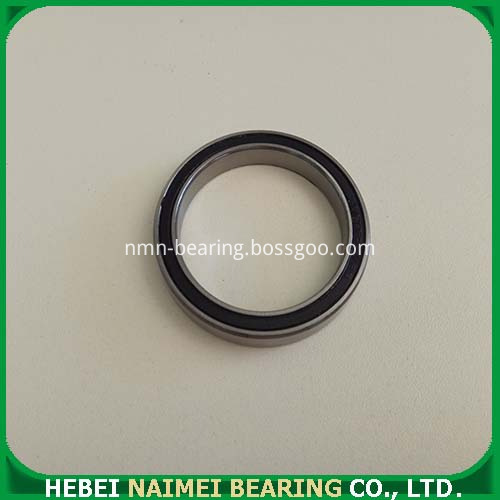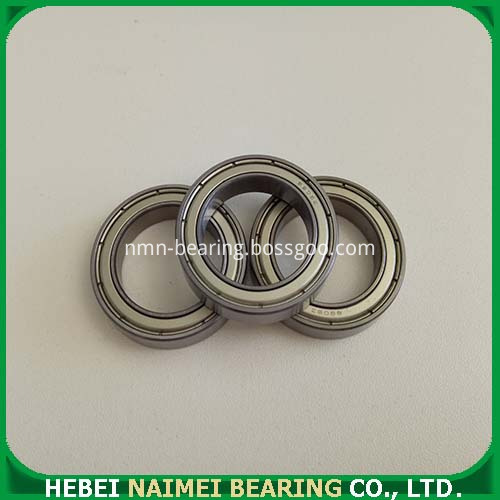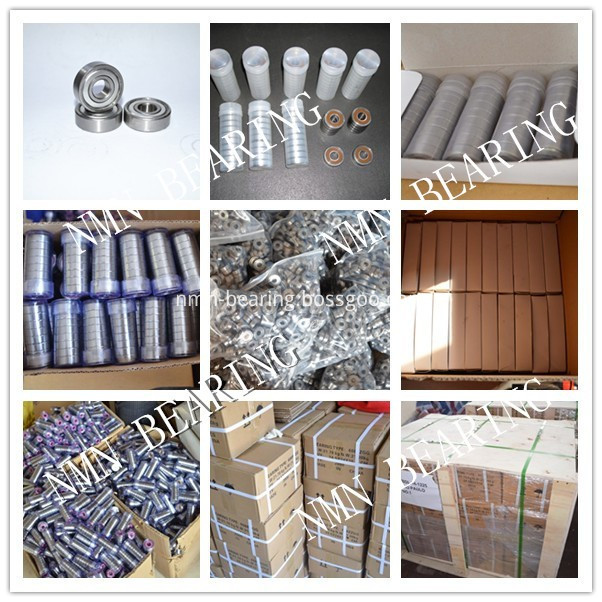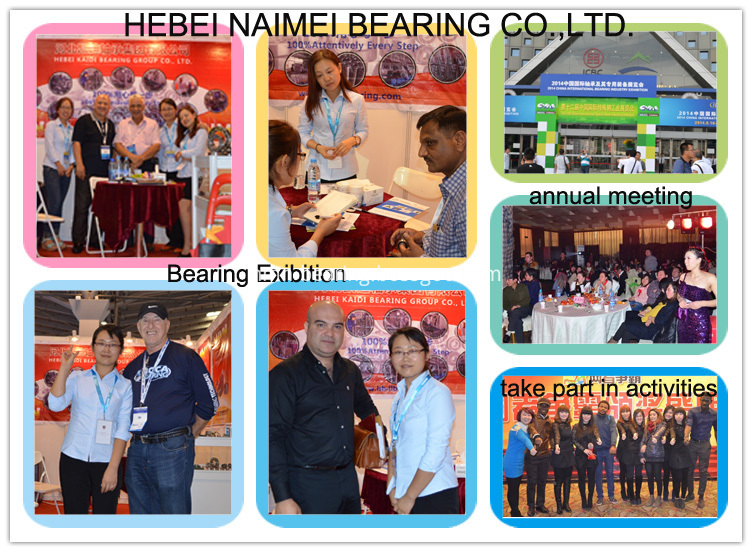6800 Series Deep Groove Ball Bearing
Thin wall type bearing(thin wall bearings) has realized the extremely thin cross section of the bearing, also has realized the product miniaturization, lightweight,so is also called thin section ball bearings. The diversity of products extends its application scope. Realized the extremely thin cross section of the bearing, also has realized the product miniaturization, lightweight. The diversity of products extends its application scope. Open, ZZ 2RS Thin Deep groove ball bearings are widely used in water pumps, Food processing machinery and high speed machine tools.
Product Show:
Packing:
1 Industry package: 200pcs/plastic bag, 2000pcs /carbon , 50 cartons/pallet ,
Packing Photos:
Workshop:
Shippment:
Exhibition:
6800 Series Deep Groove Ball Bearing 6800 Series Deep Groove Ball Bearing,Smooth Thin Wall Bearing,6801 Ball Bearing Hebei Naimei Bearing Co., Ltd. , https://www.nmn-bearing.com
Z-wave, Zigbee, Allseen, Thread Four kinds of smart home technology standards We know the smart home technology standards, but also we are most familiar with the possibility of Wi-Fi and Bluetooth. But in fact, in addition to Wi-Fi and Bluetooth, there are two smart home technology standards that are currently applied, one is Z-wave and the other is Zigbee. Let's first meet one by one.
1. Z-wave: Short-range wireless communication technology
According to the definition of Baidu Encyclopedia, Z-Wave is a wireless networking specification dominated by Danish company Zensys. It is an emerging radio frequency-based, low-cost, low-power, high-reliability, short-range wireless communication technology suitable for networks. Since it is a short-range wireless communication technology, it should be suitable for home. Therefore, it is used in residential, lighting commercial control and status reading applications such as meter reading, lighting and home appliance control, HVAC, access control, anti-theft and fire detection.
In addition, it can convert any independent device into a smart network device, enabling control and wireless monitoring. Therefore, when it was originally designed, it was positioned in the field of smart home wireless control. In other words, it is for wireless control of smart homes.
As for how it achieves technical control, let's take a small example and you will understand. The three-bedroom, one-bedroom home has three lighting control switches, three wall switches, a remote control, and a touch control screen. All devices are guaranteed to be connected, then you can see the switch status of all Z-Wave appliances in your home through the remote control and touch control screen, and you can easily control it.
2, Zigbee: Wireless network protocol for low-speed short-distance transmission
According to the definition of Baidu Encyclopedia, ZigBee is a low-power LAN protocol based on the IEEE 802.15.4 standard. “bee†is the meaning of a bee, and “zig†is the “click†sound of a bee moving wings. Therefore, it is also called the Zigbee agreement. Bees rely on this way to form a communication network in the group.
ZigBee is characterized by close range, low complexity, self-organization, low power consumption, and low data rate. It is mainly suitable for the field of automatic control and remote control and can be embedded in various devices. In other words, it is a wireless network protocol for low-speed short-distance transmission.
ZigBee also applies to smart homes. When I interviewed Nanoleaf smart light bulbs, Chong.Zhang, marketing director of Nanoleaf China, told me that Nanoleaf is using ZigBee communication protocol and light bulb lighting equipment to achieve communication (click here for details: Nano leaf: Smart Light Bulb Controlled by Siri". Therefore, using the Zigbee protocol can achieve intelligent device communication.
As for Z-wave and Zigbee, which is better, it is said on the Internet that Z-Wave aims at home automation applications at the beginning of its establishment, while ZigBee pursues a wider range of applications. Therefore, the original guiding principles of the two are not the same. They also have their own advantages and disadvantages. As for the choice of which technology to use as the basis for its own products, it is up to the company itself to decide.
3, Allseen: Internet of Things Alliance
When it comes to Allseen, it should be the Allseen Alliance. An IoT alliance made up of Linux Foundation, Qualcomm, LG, Sharp, Haier, Panasonic, HTC, Silicon Image, TP-Link, Cisco and others.
The original framework of the AllSeen Alliance was derived from the All Joyn open source project, which was mainly driven by the Qualcomm Innovation Center. It later involved processor vendors, network infrastructure vendors, router vendors, and home terminal vendors. Enterprises joining the alliance hope to be able to communicate with each other.
In September 2014, AllSeen Alliance Chairman LiatBen-Zur reported on the work of the AllSeen Alliance on his blog: He has already had nine important members and 42 community members; eight member-led working groups are actively Work to submit better code for additional features and improvements such as security and lighting; two versions of All Joyn have been released, including the SDK; AllJoyn projects can be extended to all HLOS platforms, from Android to IOS to Linux , Open WRT, Windows and even embedded RTOS solutions with extremely limited memory and processing power.
It can be seen from the work process that the Allseen Alliance is trying to bring an open platform to everyone, at least within the members, to make the code open, so that the products between members can be integrated into the technical standards.
4, Thread: Google led the alliance
After Google acquired Nest, it was dominated by Nest, members of which include ARM, Silicon Labs, Freescale, and Samsung's industrial group Thread Group, which announced the 1.0 version of the Thread specification. Thread is actually a league standard for another group of companies. At the time of publication, everyone believed that "the standards of the Internet of Things will be unified." Why do you say that? Because Thread has several advantages:
1. Advantages of the Thread protocol: Support IPv6 through 6LoWPAN technology, improve the disadvantage that Bluetooth does not support IPv6, and ZigBee cabling is complicated.
2. Thread's openness: Thread focuses on the design of a networking layer that allows a wide range of Internet of Things solutions to interoperate, while also seeking broader opportunities for collaboration.
3. The appeal and influence of Thread Group: From the initial 7 to the current 160, even Qualcomm has joined the board of directors.
Of course, for Thread, there is obviously a mark of Google, which means that like Android, it represents a standard of attributes. Because there are windows and IOS systems, whether they are willing to enter the system, apparently have not seen any signs.
Written here, many people in the home industry have to ask, what are these technical standards related to us? Why should we understand the technical standards of smart home? This does not seem to bring any benefit to our products.
1. The Internet of Things needs the support of technical standards First, we need to make it clear that if we want to achieve smart home, we need to connect objects and things, like going out, timing the rice cooker, and the door will automatically open and the lights will automatically turn on. The rice is also cooked. There is a connection between these different devices. As long as the connection is achieved, there needs to be a technical standard to support it. Whether it is Z-wave, Zigbee, or Allseen and Thread, all need a standard to implement.
2, with the technical standards to ensure the stability of smart home systems without this unified standard, then smart home systems want to achieve complete stability is more difficult. Just like now, if we buy products with different technical standards, we will find that it is not easy to use when it is used. This is the problem. Of course, if we can achieve complete unification, it will obviously be more conducive to our use environment.
3. Our smart products do not exist in isolation, but also require this technical standard. Some people may ask, what is the relevance of our smart home products with these technologies? Is this smart sofa and smart toilet also required this technical standard? You want the user to control smart sofas and smart toilet seats from a single device. This technical standard is really needed. In other words, we do not think that our product is just a single product, as long as the user manually use it, as long as the entire system in the smart home, our products are not isolated.
What do we need to do? Make it clear that we also need technical standards, then what do we need to do: 1. Determine what kind of technical standards you want to use for your product. When developing smart home products, you need to consider which Technical standards to do your product. Some use Z-wave, some use Zigbee, or use Thread in the future. Currently, smart home products manufactured using these technical standards are mainly focused on lighting, control systems, and smart single products. The actual use of traditional household items has not yet been seen. This also shows that our traditional household items have been developed. may. When we need to make a smart home ourselves, we may want to think about which technical standards are more suitable for ourselves.
2. Keeping Focus on New Technology Standards In addition, we also need to maintain our focus on new technology standards. Perhaps we have not used technical standards yet, but it does not mean that we will not use the products we have developed in the future. Therefore, we need to maintain our focus on new technology standards. Perhaps in the near future, the standards of the Internet of Things will be truly unified, so we will use our unified standards to build our own products.



2 Tube Package: 10PCS/tube,then put in Carton and Pallet
3 Single Package: 1PC/single box, then put in Carton and Pallet
And also we can pack according to your requirement.




What are the technical standards for smart homes?
Why do different smart home devices in our home work in the same environment because there is Wi-Fi? If there is no Wi-Fi outside, why can you still see the situation at home and why can some smart home products be controlled with Siri? During the interview with the smart home business, I heard the name of an agreement: Zigbee, what is Zigbee, and what it is used for, why should we understand it? Today we will take a look at several standards of smart home technology.